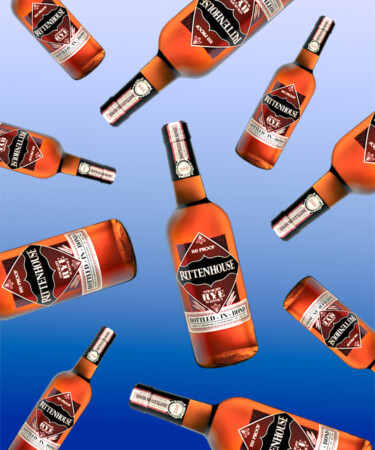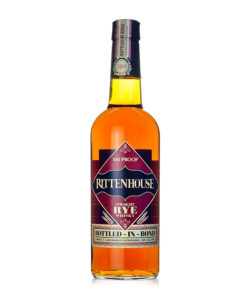Prior to today’s bourbon boom, rye whiskey was known as America’s native spirit. And before Prohibition curtailed the category’s growth, rye was also recognized as the most popular whiskey in the country. In order to regain the favor of whiskey drinkers who were turning their backs on rye in favor of bourbon after the repeal of the 18th Amendment, Rittenhouse Rye was introduced in 1934 by the Continental Distilling Corp. in Philadelphia. The whiskey, which is now owned by Heaven Hill Distillery, is bottled-in-bond and recommended by spirits professionals as a great bang for your buck. Now that you know the basics, here are seven more things you should know about Rittenhouse Rye.
Rittenhouse’s founder got his start in the industry years before the brand was created.
Prior to founding Continental Distilling Corp., Harry Publicker got his start in the whiskey industry in 1913 when he began sweating old whiskey barrels to extract the few gallons of spirit still soaked into the oak. He then proceeded to sell this whiskey as industrial alcohol, and only stopped when the government attempted to prosecute him for avoiding paying revenue tax. In order to expand his operations, Publicker opened a distillery on Philadelphia’s waterfront, which sold alcohol products to the United States government during World War I. As Prohibition did not ban the production and distribution of industrial-use alcohol, Publicker’s distillery was allowed to maintain operations. After Prohibition was lifted in 1933, Publicker spent the equivalent of $27 million to expand his distillery into the Continental Distilling Corp., where Rittenhouse Rye was produced until the 1980s.
It’s named after one of the original open-space parks planned by William Penn.
When granted the territory of Pennsylvania, Quakers sought to create a safe haven for religious, gender, and racial equality. Quaker leader William Penn planned the city of Philadelphia around this idea and divided the city into four quadrants, each of which had its own open green spaces for civilians to gather and share ideas. Rittenhouse Square was one of these four public spaces, still accessible to the public today, along with Logan, Franklin, and Washington Squares. Rittenhouse Rye was actually originally named Rittenhouse Square Rye Whiskey when it was released in 1934. However, the word “Square” was dropped from the brand name in 1948.
The whiskey wasn’t always bottled-in-bond.
When Rittenhouse Rye was first introduced to consumer markets by the Continental Distilling Corp. of Philadelphia, it was bottled as a 100 proof whiskey aged for two years, which provided the spirit with a full-bodied and mellow profile. However, the onslaught of World War II and the subsequent recovery years threatened Rittenhouse’s production due to severe wartime shortages and production stoppages. To alleviate this problem, Rittenhouse Rye’s recipe, along with its name, changed in 1948 to be a bottled-in-bond, 4-year-old whiskey. As a bottled-in-bond spirit, Rittenhouse Rye is required to be bottled at 100 proof and aged for at least four years under supervision to ensure no barrel tampering occurs over the course of the aging process.
The brand’s 1999 sale to Heaven Hill saved it from extinction.
Over the course of the ‘70s and ‘80s, sales in every whiskey category were on a steady downturn as younger drinkers turned toward clear spirits like vodka and away from the dark liquors their parents enjoyed. By the 1980s, all of the rye distilleries in the Mid-Atlantic, including the Continental Distilling Corp., had gone out of business, and a sale to a larger distiller was necessary to save the brands under Continental’s umbrella. Once Rittenhouse Rye was acquired by Heaven Hill in 1999, the large distillery — best known for its bourbon production — began making rye just one day a year and found it to be enough to meet demand. Despite low demand, Rittenhouse Rye was able to survive whiskey’s fall from grace. Its sales increased in the early 2000s during a cocktail renaissance that had bar professionals referencing classic recipes from the 1800s. Within these recipes, mixologists were able to see that rye, not bourbon, was most often listed as the base whiskey. Rittenhouse, the only bottled-in-bond whiskey on the market, proved to mix beautifully in these cocktails and thus became a mainstay on back bars.
Rittenhouse is produced in the Pennsylvania rye style.
While rye can legally be produced in any country or state, there are two predominant styles of rye: Pennsylvania and Maryland. The former, made famous by distillers from the Monongahela Valley in Western Pennsylvania, is typically made with a high concentration of rye and little to no corn. Maryland style rye, on the other hand, contains a substantial amount of corn to sweeten the spirit. As Rittenhouse Rye originated in Philadelphia, geographically, the distillers were closer to those producing in the Maryland style. Today, though Heaven Hill claims that Rittenhouse Rye is produced in the Pennsylvania style, its mash bill contains 51 percent rye, 37 percent corn, and 12 percent malted barley.
Rittenhouse is a great cocktail rye.
All bottled-in-bond spirits must be bottled at a minimum of 100 proof, or 50 percent ABV. Due to their higher alcohol content as well as a minimum four-year age requirement, bottled-in-bond spirits make for great cocktail bases. The spirit carries bold flavors of its own that mingle nicely with cocktail mixers. “Any bonded whiskey is great for cocktails due to the elevated proof,” says Jay Erismann, co-founder of New Riff Distilling, in an interview with VinePair. “The whiskey in the bottle will be very consistent, coming all from the same distilling season.” We recommend mixing Rittenhouse into your favorite Boulevardier or Manhattan recipe.
Rittenhouse isn’t afraid to go against the grain.
Over the course of the last decade, as whiskey sales have increased, the color green has become somewhat synonymous with rye. As argued by whiskey writer Clay Risen: “I think of rye as being an herbal spirit. The notes that come to mind first are herbal notes — thyme, basil, bell pepper. Rye works better as a younger spirit than bourbon does, so I think green speaks to that well.” Labels on ryes from Bulleit, Jack Daniel’s, Knob Creek, and a multitude of other brands are green or have a touch of green embedded in the design while some brands, like Jim Beam, have changed their labels to incorporate the color. Despite most other ryes utilizing the woodsy color, Rittenhouse Rye has thus far stuck with its black and white label.

